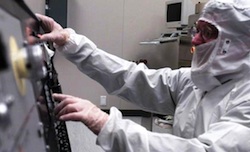Assemblageddon
 A few weeks ago I wrote about the need for a perception shift in our culture: that we need to stop equating the concept of “manufacturing” with the lowbrow reality of “assembly.” For more than a century, because of assembly lines, people have naturally gravitated towards that association. And assembly as a mechanism for manufacturing isn’t going anywhere.
A few weeks ago I wrote about the need for a perception shift in our culture: that we need to stop equating the concept of “manufacturing” with the lowbrow reality of “assembly.” For more than a century, because of assembly lines, people have naturally gravitated towards that association. And assembly as a mechanism for manufacturing isn’t going anywhere.
Well, that’s not precisely true. It’s going to Mexico, India, and China, where hordes of individuals with minimal skills and minimal training can build complex products for what we in North America would consider a very low wage. Those assembly jobs once lived on our shores, and their departure has seriously damaged the U.S. economy. But it’s still wrong-headed to assume that moving all the assembly lines to China means manufacturing in the United States is on life support. Assembly in the United States is on life support; and frankly, we have to come to grips with the fact that it’s time to pull the plug.
American workers who lost their assembly jobs to outsourcing need help… but that help shouldn’t take the form of new assembly jobs. There are two key reasons for this.
First, those jobs don’t pay well. Assembly workers are looking at maybe $35,000 a year. Certainly that’s better than nothing, but as Harold Meyerson’s January 25 op-ed in The Washington Post points out, a salary like that does not “…easily support home ownership, new-car purchases or college tuitions. A manufacturing renaissance would be good in itself… but would not in itself rebuild the great American middle class.”
Second, even if a magic wand was waved and all the iPhones and stepladders and sweaters and tables were assembled in the United States again, those restored assembly workers would remain just as vulnerable to future offshoring. Meaning, once again generations of Americans would feel secure in low-pay, low-skill jobs that history has shown aren’t secure at all.
It’s preferable to let emerging economies keep those assembly jobs – we can’t compete with their slave-level wages and working conditions anyway, and we wouldn’t want toInstead, the investment in American manufacturing (both economically and philosophically) should be one of education and capabilities, not assembly. Manufacturing is much more than putting things together. A robot can put things together, even another robot; but a manufacturer is the one who dreams up the process in the first place.
This viewpoint has been historically unpopular because all those people who had formerly worked in assembly don’t necessarily have the knowledge or skills to become modern American manufacturers. We are, after all, talking about some level of engineering capability – not necessarily a degree in engineering, but something beyond what’s necessary to operate a stamping machine. Some re-education will be necessary, in the short term, for all the American assemblers who want to move into the kinds of manufacturing jobs the country really needs. And those assemblers should get all the help that their government and employers can possibly provide. See? It’s not a question of jobs, it’s a question of education. The jobs exist, here, right now – but they lack the people with the appropriate skill set to fill them.
 Ignoring a problem is not the right way to solve it, though it’s often the easiest. It would surely be easier to just hope that assembly jobs return to America, or even to provide infrastructure and funding to encourage it. But would that be the right solution? No. It would create low-paying, largely unskilled jobs that would always be at risk of elimination. Meanwhile, reinventing what we mean by manufacturing, that’s going to be an expensive, long-term proposition involving heavy investment in education and change to long-held social ideologies. It’s not going to be fun, or cheap, or even fast… but it is right, and it is the true path to a revitalized manufacturing economy in the United States. A manufacturing economy that we already possess the tools for, right here, on our soil, it’s an investment in people and their opportunity for a better life, a more prosperous life.
Ignoring a problem is not the right way to solve it, though it’s often the easiest. It would surely be easier to just hope that assembly jobs return to America, or even to provide infrastructure and funding to encourage it. But would that be the right solution? No. It would create low-paying, largely unskilled jobs that would always be at risk of elimination. Meanwhile, reinventing what we mean by manufacturing, that’s going to be an expensive, long-term proposition involving heavy investment in education and change to long-held social ideologies. It’s not going to be fun, or cheap, or even fast… but it is right, and it is the true path to a revitalized manufacturing economy in the United States. A manufacturing economy that we already possess the tools for, right here, on our soil, it’s an investment in people and their opportunity for a better life, a more prosperous life.










